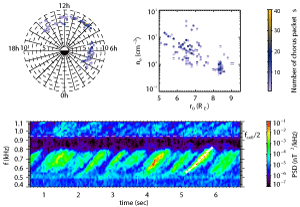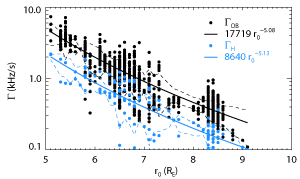
2012 THEMIS SCIENCE NUGGETS
Comparison between theory and observation of the frequency sweep rates of equatorial rising tone chorus
by Xin Tao, UCLA AOS
Introduction
Chorus waves are important electromagnetic emissions in the inner magnetosphere of Earth. They transfer energy between different groups of electrons, causing the increase of energetic electron flux in the dynamic outer radiation belt. Chorus waves can also scatter energetic electrons into the atmosphere, forming the diffuse aurora and the pulsating aurora.
One characteristic feature of chorus is that the frequency of the wave varies rapidly with time if observed at a given location (see Figure 1). Various theories have been proposed to explain this process. Predictions of the frequency sweep rate made by these theories can correspondingly be compared with satellite observations.
We compiled a dataset from observations of THEMIS (see Figure 1) and compared observations with two theories in this work: one proposed by Helliwell in 1967 and one proposed by Trakhtengerts in 1995. Both theories were developed for a dipole magnetic field. We slightly extended both theories to use a realistic magnetic field model (T89 model) so that the effects of geomagnetic activity and magnetic local time could be included in the calculation of chorus frequency sweep rates. Both factors have been shown to affect the frequency sweep rate (Γ) of chorus by previous work.
| Figure 1. The distribution of THEMIS data (top left) as a function of MLT and the radial distance r0 in units of Earth radius RE, and (top right) as a function of electron density (ne) and radial distance r0. Color coded is the number of selected chorus packets within each time interval which lasts about 6 to 14 seconds. (bottom) One chosen time interval of chorus packets from THEMIS A on 2008/07/26 starting from 13:52:23.668 UT (r0 = 8.0 RE, MLT = 11.9 h, and λM = 2.7°), where the dashed line represents fce0/2. Crosses represent manually selected points within the packet between 5 s and 6 s, and the solid white line is the linear fitting whose slope gives the frequency sweep rate. Color coded is the magnetic field wave power spectral density. |
Results
We first demonstrated in our paper that the theoretical dependence of Γ on various background plasma parameters, including magnetic local time (MLT), geomagnetic activity level (characterized by Kp index), electron density, and geocentric radial distance r0, are similar to the theories of Helliwell and Trakhtengerts. We thus only show the comparison between Γ of Helliwell with observations here, and the comparison with THEMIS data is shown in Figure 2. Good agreement between theory and observation in terms of scaling is shown. However, the absolute value of the theoretical frequency sweep rate is larger than the observed rate by about a factor of two.
| Figure 2. The comparison between the observed frequency sweep rate Γ OB (black dots) and the theoretical frequency sweep rate ΓH from Helliwell [1967] (light blue dots). The theoretical frequency sweep rate ΓH is calculated using observed MLT, Kp, electron density, and r0 with the T89 magnetic field model. The solid black line is a power-law fitting of ΓOB as a function of r0 while the solid light blue line is a power-law fitting of ΓH as a function of r0. The dashed lines are the corresponding standard deviation of the results from the fitting functions. |
Conclusion
In conclusion, the theoretical frequency sweep rate of chorus given by Helliwell is comparable with observations from THEMIS. Good agreement between theory and observation is found in terms of scaling. The theory is also used to explain the dependence of the chorus frequency sweep rate on magnetic local time, as demonstrated in the paper cited below.
Reference
Tao, X., W. Li, J. Bortnik, R. M. Thorne, and V. Angelopoulos (2012), Comparison between theory and observation of the frequency sweep rates of equatorial rising tone chorus, Geophys. Res. Lett., 39, L08106, doi:10.1029/2012GL051413.Biographical Note
Xin Tao is an assistant researcher at Department of Atmospheric and Oceanic Sciences, UCLA. His current research includes the nonlinear interactions between energetic electrons and chorus waves.
 Please send comments/suggestions to
Emmanuel Masongsong / emasongsong @ igpp.ucla.edu
Please send comments/suggestions to
Emmanuel Masongsong / emasongsong @ igpp.ucla.edu


